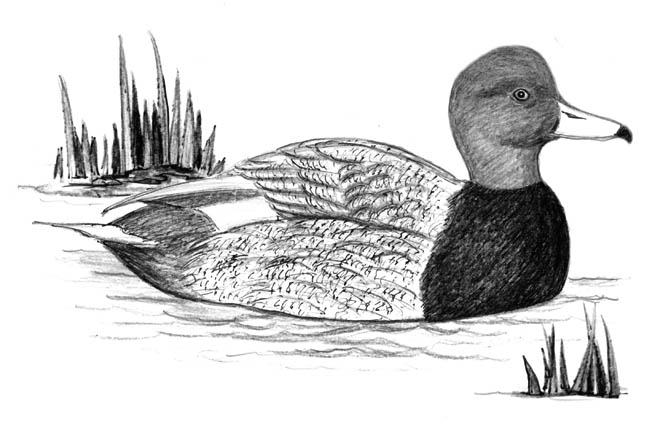
Dear Bird Folks,
For the past few weeks I’ve been watching Redhead Ducks on a pond near my house. Then I read your column about some other ducks called “Canvasbacks,” which also have red heads and now I’m confused. I’m worried that the Redhead Ducks I’ve been seeing are, in fact, Canvasbacks. Please help.
– Carla, Falmouth, MA
Welcome, Carla,
Welcome to the world of birding. Birding is one of those hobbies where confusion is the norm. If they wanted birding to be easy, they never would have invented sparrows. But unlike sparrow identification, learning to identify most ducks, including Redheads and Canvasbacks, is actually possible. (BTW: They are called just “Redheads,” not “Redhead Ducks.” The duck part is understood.) Here’s something else you might not know. Based on fall waterfowl surveys, your town, Falmouth, annually wins the title as the Duck Capital of Cape Cod. Falmouth has three times the number of ducks than the next closest Cape town. How about that? Go, Falmouth!
Each winter I drive to Falmouth to check the ponds and this year I was looking forward to seeing those reported Redheads. But before I left town I made sure I stopped for gas. (I know Falmouth is perfectly normal to you, Carla, but for someone from Orleans, it’s like venturing to the outer edges of the universe.) While I was pumping gas, a lady yelled to me (and this is true), “Are you going birding?” To which I replied, “Of course.” She then said, “What are you looking for?” and I answered, “Redheads.” That seemed like an innocent response to me, but I could tell the lady had a totally different image going through her mind. After a moment of awkward silence, I said, “Redheads are ducks.” The lady seemed relieved, nodded and smiled, but I’m still not sure she believed me.
This is how to tell the difference between Canvasbacks and Redheads. If you recall the Canvasback column, I mentioned that the male Canvasbacks earned their common name from their light, “canvas-colored” bodies. Redhead males don’t have white bodies. Their bodies are gray. Remember that lame Disney movie from the 60s, The Horse in the Gray Flannel Suit? Well, a Redhead is like that horse, only it’s a duck. I know that doesn’t make much sense, but it’s the best analogy I could come up with…and it’s still better than that awful movie.
Here are a few more clues. You were right when you said both Canvasbacks and Redheads have red heads, but the shades of red on the two ducks are not the same. Canvasbacks have kind of dark, rusty heads. While the red on the head of a Redhead, is bright red, like a stop sign…or the Pope’s shoes. However, the exact shade of red on either duck can be affected by ambient light. So to me, the biggest difference between the two birds is the shape of their heads. Redheads have round heads, looking like Charlie Brown, but with a beak. Canvasbacks, on the other hand, have long, tapered foreheads, like a Common Eider, or a doorstop. This characteristic is key to identification. It can be used in any season, in any light and with either sex. Winter or summer, male or female, Redheads will be the ones with the round, Charlie Brown heads, while Canvasbacks will always be the ones in serious need of a nose job.
Speaking of Redhead females, these crazy lady ducks have one of the most interesting nesting arrangements in the duck world. A typical duck’s breeding success hinges on several factors, including food availability and the overall health of the female. If there is a food shortage (usually caused by a drought) or if a particular female is in poor health or underweight (from a tough winter), she may not breed at all that year. But neither of these problems bothers Mrs. Redhead very much. If she isn’t strong enough to hatch her own eggs, she will simply lay her eggs in the nest of some neighbor duck and let her worry about them. And believe it or not, this plan usually works. In most cases the foster duck is another Redhead, but it could also be a Canvasback, a Mallard or even a coot. And a few misguided Redheads have been known to lay their eggs in the nests of ground-nesting harriers (hawks). My guess is that doesn’t turn out very well…except for the harriers.
Here’s where it gets weirder. Sometimes there is plenty of food and Mrs. Redhead is strong and healthy, yet she still may lay some of her eggs in another duck’s nest. Then, after that, she will go off and build her own nest, lay more eggs and start another family, which she personally takes care of. I know starting two families and only taking responsibility for raising one of them sounds like something you’d see on the Maury Povich Show, but it’s a great idea (if you’re a duck). By not putting all of her eggs in one basket, the female Redhead has increased the odds that some of her ducklings will survive to adulthood. She doesn’t care who raises her kids. Her only goal is to create a new generation of Redheads…well, that, and appearing on the Maury Povich Show. Ducks love Maury.
The next time you see your Redhead/Canvasbacks, Carla, look for light vs. gray bodies. Light equals canvas. Gray equals the Redhead in the gray flannel suit. More importantly, if it has a round Charlie Brown head, it’s a Redhead. But if it has a really long face, then it’s either a Canvasback, or Secretary of State, John Kerry. It’s impossible to tell those two apart.